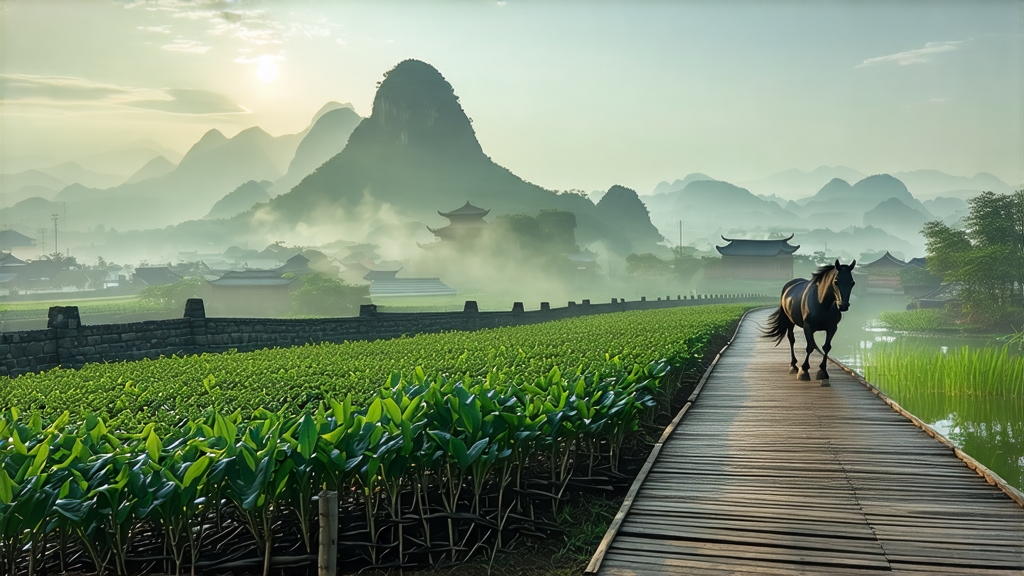
Liu Bao—pronounced “lee-ow bao”—is the quiet genius of China’s dark-tea family. While Pu-erh hoards the limelight, this cousin from Guangxi Zhuang Autonomous Region has been riding caravans, curing dysentery and smoothing digestion for fifteen centuries. Its name simply means “six forts,” a nod to the six stockades that once guarded the trade pass from the mist-wrapped mountains of Wuzhou to the Pearl River delta. Merchants compressed the leaf into tight baskets, loaded it onto bamboo rafts, and floated it down the Liu River to Guangzhou, where dockside humidity began the slow microbial dance that still defines the tea today.
History first records Liu Bao during the Tang dynasty (618-907 CE) when it was listed as “mountain tea from Cangwu county,” taxed and bartered for salt. By the Qing era it rode the famed Tea Horse Road westward into Tibet and Mongolia, prized by nomads for its ability to cut through yak-butter richness and alleviate altitude sickness. In 1801 the Jiaqing Emperor granted it gong cha status—“tribute tea”—and 50 dan (about three tonnes) were shipped north each spring. The Republican period saw basket after basket disappear into Southeast Asia with coolie laborers; today Kuala Lumpur’s old kopitiam still serve it in thick glasses, believing the brew dissolves the cholesterol of coconut-laden diets.
Liu Bao is not a single cultivar but a processing method applied to the large-leaf taxa Camellia sinensis var. sinensis f. pubilimba that carpets the granite peaks of Guangxi. Locals divide it into four commercial grades—Special, First, Second, Third—based on bud ratio and leaf size, yet connoisseurs speak in vintage years and storage towns much like wine lovers cite châteaux. The most sought-after lots are the “old basket” 篓装茶, 40–50 kg horseshoe-shaped bundles laced with bamboo bark that allow micro-oxygenation during decades of tropical aging.
Making Liu Bao is a dialogue between fire, water and time. Picking occurs from April to September; a standard basket needs 25,000 two-leaf-and-a-bud plucks. The leaves are immediately wilted under mountain shade, then wok-fired at 200 °C for eight minutes to kill green enzymes—noticeably shorter than Pu-erh’s shaqing, preserving more surface microbes. Rolling follows, 45 minutes of arm pressure that ruptures cells without shredding the leaf. What happens next is the tea’s signature: duī wēn 堆温, a controlled wet-pile fermentation borrowed centuries ago from Guangdong’s tea merchants. The semi-dry leaf is heaped 70 cm deep, sprayed to 28 % moisture, covered with jute and left for 25–35 days. Internal temperature climbs to 55 °C; thermophilic Aspergillus, Blastobotrys and Bacillus species bloom, oxidizing catechins into theaflavins and gallic acid, gifting the deep betel-nut aroma Chinese call song xiang—pine-wood meets dried longan. When the pile exhales a sweet, earthy note the tea is “turned,” aired and restacked up to three times. Finally the leaf is steamed, pressed into baskets or 500 g bricks, and moved to Guangxi’s natural “wet warehouses,” concrete cellars where humidity hovers at 85 % and temperature at 28 °C year-round. Here Liu Bao sleeps, slowly darkening for decades while its microbes continue to nudge polyphenols into mellow, reddish-brown liquor.
To brew Liu Bao is to summon a miniature geography. Start with 5 g for 120 ml—about the weight of a Malaysian gold dinar—rinsed twice with 100 °C water to awaken the leaf and wash away cellar dust. Use porcelain or a seasoned Yixing duan-ni clay pot; the latter’s porous iron-rich body rounds off the tea’s edges. The first real infusion, 10 seconds, pours the color of antique mahogany. Bring the cup to your nose: camphor, nutmeg and the faintest whiff of rain-soaked camellia flowers. Sip briskly, letting the liquid coat the tongue; acidity arrives first, like dried hawthorn, then a brown-sugar sweetness lingers at the back of the throat